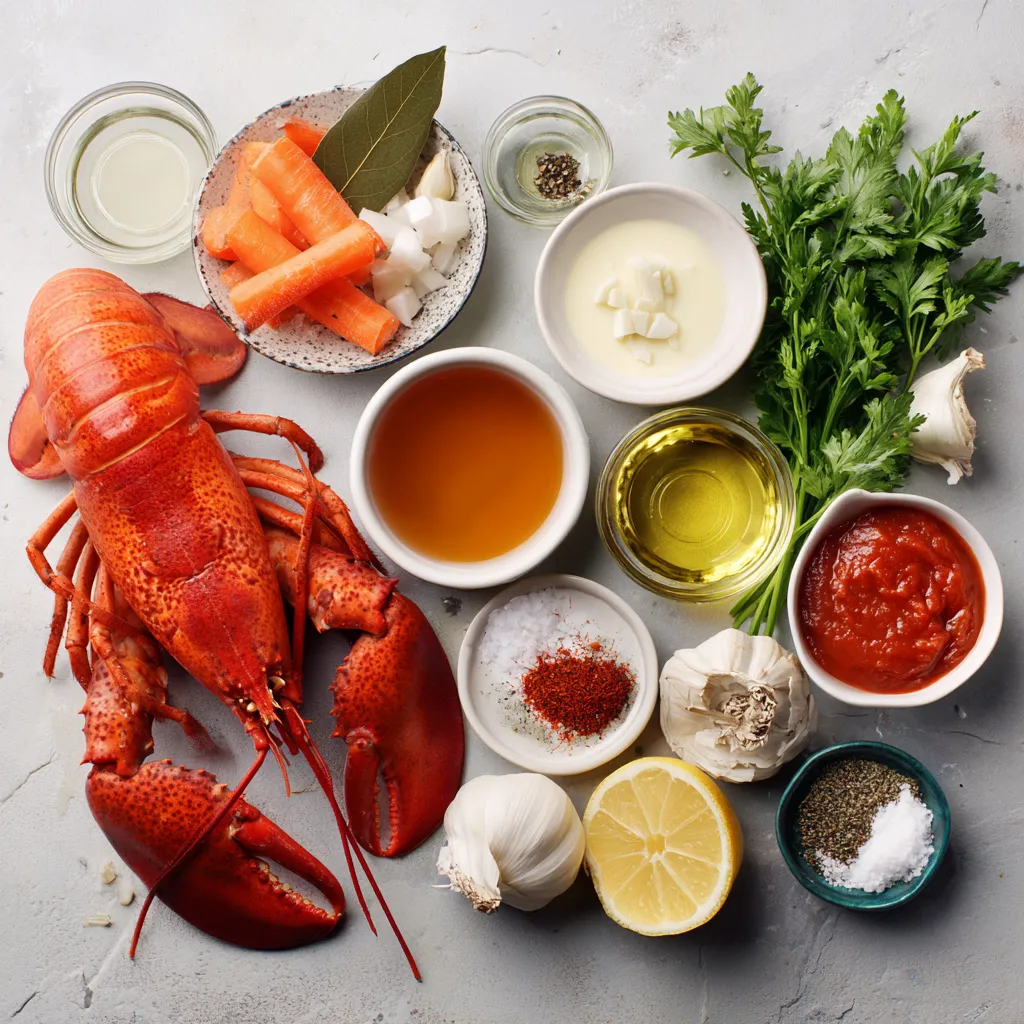Introduction
The rich, velvety texture of Lobster Delight Bisque makes it a standout dish, perfect for special occasions or a cozy night in. This recipe combines the delicate flavors of fresh lobster, aromatic vegetables, and a touch of cream, creating a luxurious experience for your palate. The complexity of flavors and the silky consistency of this bisque not only tantalizes the taste buds but also elevates the dining experience to a gourmet level.
Serving this sumptuous bisque is ideal for intimate gatherings or as an impressive first course when hosting a dinner party. Whether you’re a seasoned chef or a novice in the kitchen, this bisque will surely impress your guests while allowing you to showcase your culinary skills. The balance of flavors and textures in this dish sets it apart from standard soups, making it a dish to remember.
Recipe Overview
– Total Time: 1 hour
– Prep Time: 30 minutes
– Yield: 4 servings
– Difficulty: Not specified in the recipe
Ingredients
– 2 live lobsters (approximately 1 ½ pounds each)
– 4 cups seafood stock
– 1 cup heavy cream
– 1 small onion, finely chopped
– 2 cloves garlic, minced
– 1 large carrot, diced
– 2 celery stalks, diced
– 1 tablespoon tomato paste
– ¼ cup unsweetened white grape juice
– 1 bay leaf
– 1 teaspoon fresh thyme, chopped
– 1 teaspoon smoked paprika
– Salt and pepper, to taste
– 2 tablespoons olive oil
– Fresh parsley, chopped (for garnish)
– Lemon wedges (for serving)

Instructions
1. Cook the Lobsters: In a large pot, bring salted water to a rolling boil. Carefully add the live lobsters and cook for about 8-10 minutes or until their shells turn a vibrant red. Once cooked, remove them from the water and allow them to cool. After they’ve cooled, extract the meat from the tails and claws, chopping it into bite-sized pieces. Set the lobster meat aside and keep the shells for later use.
2. Prepare the Base: In a large saucepan, heat the olive oil over medium heat. Add the finely chopped onion, minced garlic, diced carrot, and diced celery. Sauté this mixture for around 5-7 minutes or until the vegetables become tender and fragrant.
3. Build the Flavor: Incorporate the tomato paste, bay leaf, chopped thyme, and smoked paprika into the sautéed vegetables. Stir well and cook for an additional minute to let the spices bloom, enhancing the mixture’s aroma.
4. Deglaze the Pan: Pour in the unsweetened white grape juice, using a wooden spoon to scrape up the flavorful browned bits stuck to the bottom of the pan. Allow it to simmer for 2-3 minutes until the liquid has reduced slightly.
5. Add the Stock: Pour the seafood stock into the pot, and add in the reserved lobster shells. Bring the mixture to a gentle simmer and let it cook for 20 minutes to meld the flavors beautifully.
6. Blend the Bisque: After simmering, carefully remove the lobster shells and bay leaf from the pot. Use an immersion blender or a standard blender to puree the bisque until it reaches a silky smooth consistency. Return it to the saucepan.
7. Finish with Cream: Stir in the heavy cream, followed by the chopped lobster meat. Season with salt and pepper to taste. Heat the bisque gently over low heat for about 5 minutes—do not let it reach a boil to preserve the creaminess.
8. Serve and Garnish: Ladle the rich bisque into individual bowls. Garnish with freshly chopped parsley for a pop of color, and serve alongside lemon wedges for an added burst of freshness.
Cooking Lobsters
The foundation of any lobster dish lies in the quality of the lobster itself. When selecting lobsters, opt for live ones, which provide optimal flavor and freshness. Look for lobsters that weigh approximately 1 ½ pounds each, as this size tends to yield the best meat-to-shell ratio.
The cooking method greatly influences the texture and taste of the lobster. Boiling is the preferred method because it allows the lobster to cook evenly while retaining moisture. To achieve perfectly cooked lobster, bring a large pot of salted water to a rolling boil before adding the lobsters. Cooking time is about 8-10 minutes, and the lobsters are ready when their shells turn a vibrant red.
After boiling, it’s essential to properly extract the lobster meat from the claws and tails. To do this safely, let the lobsters cool slightly before handling them. Use a sharp knife to carefully cut through the shell, allowing you to extract the tender meat without damaging it. Chop the meat into bite-sized pieces to ensure an even distribution throughout the bisque.
Preparing the Base
The base of the bisque is where the flavor begins to develop, and the choice of vegetables plays a significant role in contributing to this flavor profile. Onions, garlic, carrots, and celery form the classic aromatic foundation known as mirepoix. When selecting these vegetables, choose a small onion that is firm and fragrant, garlic cloves that are fresh and plump, sturdy carrots with vibrant color, and crisp celery stalks.
The sautéing technique employed in this recipe is vital for achieving the right tenderness and flavor extraction from the vegetables. Start by heating olive oil over medium heat and add the chopped onions, minced garlic, diced carrots, and diced celery. Sauté for about 5-7 minutes until the vegetables become tender and fragrant. The goal is to soften the vegetables and allow their natural sugars to caramelize slightly, creating a sweet, aromatic base for the bisque.
The aroma of the sautéing vegetables is a good indicator of their readiness. Once they are fragrant and tender, you’re ready to advance to the next stage of building your bisque, which further enhances the depth of flavors that will carry through in the final dish.
Building the Flavor
Building flavor profiles in a bisque involves careful incorporation of various seasonings that complement the primary ingredient—lobster in this case. Tomato paste serves as a key ingredient in enhancing the umami dimension, while bay leaf, fresh thyme, and smoked paprika introduce aromatic undertones and subtle complexity.
When incorporating these ingredients, ensure you’re allowing enough time for each seasoning to cook properly and release its flavors. For example, after adding the tomato paste, let it cook for about a minute. This process, known as blooming, is when the spices become to release their essential oils and flavors, thus infusing the dish with added richness.
Recognizing visual cues during this step is crucial. Look for changes in color or texture that indicate the spices and paste have melded well with the vegetables before proceeding to deglaze the pan. This method not only enhances flavor but also prepares the base for the next steps in creating a balanced and flavorful bisque.
Deglazing the Pan
Deglazing is a technique where liquid is added to a pan to dislodge flavorful bits stuck to the bottom after sautéing. This step is essential for creating a rich base for your bisque. In this recipe, using unsweetened white grape juice adds a pleasant slight sweetness and acidity that pairs wonderfully with the lobster.
When deglazing the pan, pour the grape juice into the pot and immediately use a wooden spoon to scrape the bottom, gathering those delicious browned bits (fond). Allow the mixture to simmer for 2-3 minutes. This not only reduces the liquid slightly but also intensifies the overall flavor profile of the bisque. Proper deglazing helps blend the layers of flavor harmoniously, ensuring your Lobster Delight Bisque is as delicious and complex as possible.

of any special occasion.
Purpose of Deglazing
Deglazing is a crucial technique in creating a flavorful bisque. When sautéing vegetables and aromatics, the bottom of the pan tends to develop caramelized bits known as fond. This layer of concentrated flavor can significantly enhance the taste of the bisque. By deglazing, you lift these bits from the pan, infusing their rich essence into the broth of the bisque.
Explanation of Why Deglazing is Crucial
Deglazing allows for a deeper, more complex flavor profile in the bisque. The combination of sautéed vegetables and the fond creates a layered taste that enhances the overall richness of the dish. Without this step, the bisque may lack the depth necessary for a fully developed flavor, resulting in a less satisfying finished product.
Techniques for Deglazing
To effectively deglaze, one must use a liquid that not only lifts the fond but also complements the ingredients already in the pot. In this recipe, unsweetened white grape juice serves as an ideal non-alcoholic substitute for white wine. Here are step-by-step instructions:
– Pour the white grape juice directly into the pan after sautéing the vegetables.
– Use a wooden spoon to gently scrape the bottom of the pan, dislodging the fond.
– Allow the juice to simmer for 2-3 minutes, letting it reduce slightly for a more concentrated flavor before proceeding with adding the stock.
Adding Stock
Choosing Seafood Stock
The quality of the seafood stock plays a vital role in the final taste of the bisque. Using a homemade stock ensures that you can control the ingredients and flavor profile. Alternatively, select a high-quality store-bought option that is low in sodium to better control seasoning later.
Importance of Quality Seafood Stock in Bisque Preparation
A superior seafood stock contributes to the bisque’s overall richness. It serves as the main base, meaning that any deficiencies in flavor from a low-quality stock will ultimately affect the entire dish. The infusion of flavors from the shellfish adds subtle nuances that elevate the bisque.
Cooking with Reserved Lobster Shells
Adding the reserved lobster shells while simmering the stock enhances the seafood flavors even further. The shells release additional umami, enriching the liquid significantly. Recommended simmering time for optimal taste infusion is around 20 minutes, which allows the shells to impart their flavor without becoming overly brackish.
Blending the Bisque
Importance of Smooth Texture
A hallmark of a great bisque is its smooth texture. The silkiness of the pureed components makes each spoonful luxurious and allows the richness of the lobster and cream to shine through.
Safety Tips When Using Immersion and Standard Blenders
When blending hot liquids, exercise caution. If using a standard blender, allow the bisque to cool slightly before blending in batches. Always vent the lid to prevent steam buildup. For immersion blenders, ensure that the blender head is fully submerged to avoid splattering.
Finalizing the Texture
To ensure a smooth bisque without chunks, blend thoroughly. If the bisque appears too thick after blending, adjust the texture with additional stock or cream, blending again as necessary. Common choking hazards or unwanted bits can be eliminated through proper blending.
Finishing Touches
Adding Cream
Incorporating heavy cream is essential for elevating the bisque’s desired texture. Its richness balances the lobster and provides a luxurious mouthfeel. Timing is key; add the cream once the bisque has been blended and simmered briefly, allowing it to warm through without boiling, which ensures a smooth, creamy finish.
Adjusting Seasoning
Tasting and seasoning the bisque after adding cream is vital. This step allows you to fine-tune salt, pepper, and other spices to suit your palate. Suggestions for balancing flavors include a touch more smoked paprika or fresh herbs to brighten the dish.
Serving and Garnishing
Presentation Techniques
For an eye-catching presentation, consider ladling the bisque into warm, shallow bowls. A light drizzle of olive oil paired with a slight sprinkle of paprika on top adds an elegant touch. Accompanying with a few pieces of lobster claw on the side enriches this visual appeal.
Importance of Temperature and Serving in Warm Bowls
Serving the bisque in warm bowls is paramount to maintaining the desired temperature, ensuring a warm, comforting experience for the diner.
Recommended Accompaniments
Lemon wedges add a vibrant brightness that balances the rich flavors of the bisque. Fresh parsley not only brings a pop of color but also a fragrant herbal note that can enhance the overall eating experience. Other suggestions could include crusty bread or croutons served on the side for added texture.
Variations and Substitutions
Altering Ingredients
If there are dietary restrictions, consider using non-dairy options for the cream such as coconut cream or cashew cream. Those wishing to explore could swap lobster for other seafood like shrimp or crab, noting that cooking times may vary according to the choice of seafood.
Enhancing Depth of Flavor
To deepen the flavor profile, consider adding spices like coriander or cumin for warmth. Alternatively, combining different seafood in a mixed seafood bisque will create complex and delightful layers of taste.
Storing and Reheating
Proper Storage Techniques
For best preservation, cool the bisque to room temperature before refrigerating in an airtight container. It can also be frozen for longer storage; however, keep in mind that cream can sometimes change texture after freezing.
Recommended Containers for Best Preservation
Glass or BPA-free plastic containers with tight-fitting lids are ideal for storing bisque in both the refrigerator and the freezer.
Reheating Bisque
When reheating, always do so gently over low heat, stirring frequently. The goal is to warm without boiling, especially because high heat can curdle the cream. Consider gradually adding a splash of additional stock or cream if the bisque thickens too much during storage.
Conclusion
Lobster Delight Bisque is a magnificent dish that captivates with its luxurious texture and flavor. With a smooth, creamy consistency and delightful hints of fresh seafood, this bisque is sure to excite your taste buds. Cooking it requires careful attention to flavor-building steps and patience, but the result is a rich, satisfying soup that is worthy of any special occasion.


